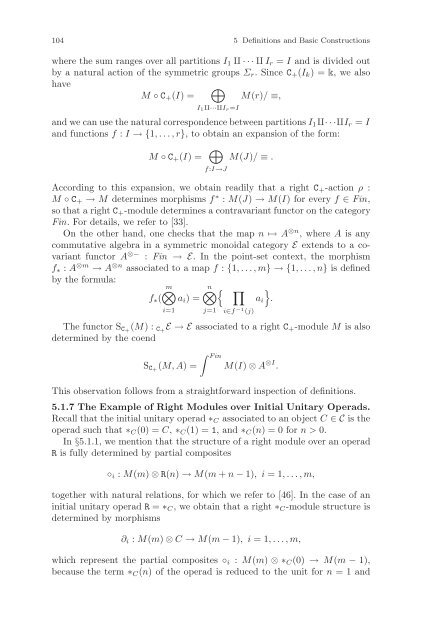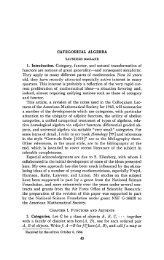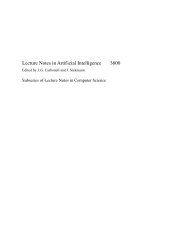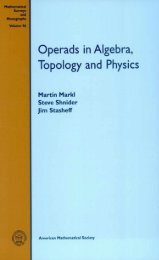Symmetric Monoidal Categories for Operads - Index of
Symmetric Monoidal Categories for Operads - Index of
Symmetric Monoidal Categories for Operads - Index of
You also want an ePaper? Increase the reach of your titles
YUMPU automatically turns print PDFs into web optimized ePapers that Google loves.
104 5 Definitions and Basic Constructions<br />
where the sum ranges over all partitions I1 ∐···∐Ir = I and is divided out<br />
by a natural action <strong>of</strong> the symmetric groups Σr. SinceC+(Ik) =k, wealso<br />
have<br />
M ◦ C+(I) =<br />
�<br />
M(r)/ ≡,<br />
I1∐···∐Ir=I<br />
and we can use the natural correspondence between partitions I1∐···∐Ir = I<br />
and functions f : I →{1,...,r}, to obtain an expansion <strong>of</strong> the <strong>for</strong>m:<br />
M ◦ C+(I) = �<br />
M(J)/ ≡ .<br />
f:I→J<br />
According to this expansion, we obtain readily that a right C+-action ρ :<br />
M ◦ C+ → M determines morphisms f ∗ : M(J) → M(I) <strong>for</strong> every f ∈ Fin,<br />
so that a right C+-module determines a contravariant functor on the category<br />
Fin. For details, we refer to [33].<br />
On the other hand, one checks that the map n ↦→ A ⊗n ,whereA is any<br />
commutative algebra in a symmetric monoidal category E extends to a covariant<br />
functor A ⊗− : Fin → E. In the point-set context, the morphism<br />
f∗ : A ⊗m → A ⊗n associated to a map f : {1,...,m}→{1,...,n} is defined<br />
by the <strong>for</strong>mula:<br />
m�<br />
f∗( ai) =<br />
i=1<br />
n� � �<br />
j=1<br />
i∈f −1 (j)<br />
The functor SC+ (M) :C+ E→Eassociated to a right C+-module M is also<br />
determined by the coend<br />
ai<br />
�<br />
.<br />
� Fin<br />
SC+ (M,A) = M(I) ⊗ A ⊗I .<br />
This observation follows from a straight<strong>for</strong>ward inspection <strong>of</strong> definitions.<br />
5.1.7 The Example <strong>of</strong> Right Modules over Initial Unitary <strong>Operads</strong>.<br />
Recall that the initial unitary operad ∗C associated to an object C ∈Cis the<br />
operad such that ∗C(0) = C, ∗C(1) = 1, and∗C(n) =0<strong>for</strong>n>0.<br />
In §5.1.1, we mention that the structure <strong>of</strong> a right module over an operad<br />
R is fully determined by partial composites<br />
◦i : M(m) ⊗ R(n) → M(m + n − 1), i=1,...,m,<br />
together with natural relations, <strong>for</strong> which we refer to [46]. In the case <strong>of</strong> an<br />
initial unitary operad R = ∗C, we obtain that a right ∗C-module structure is<br />
determined by morphisms<br />
∂i : M(m) ⊗ C → M(m − 1), i=1,...,m,<br />
which represent the partial composites ◦i : M(m) ⊗∗C(0) → M(m − 1),<br />
because the term ∗C(n) <strong>of</strong> the operad is reduced to the unit <strong>for</strong> n =1and






